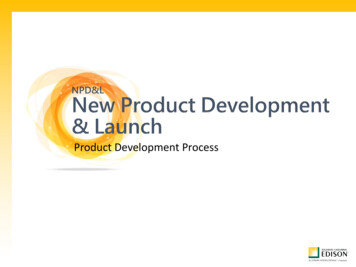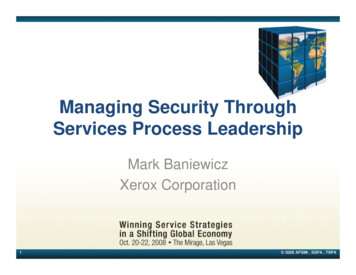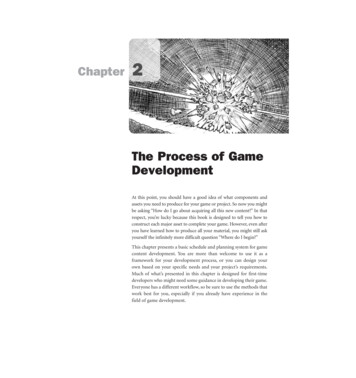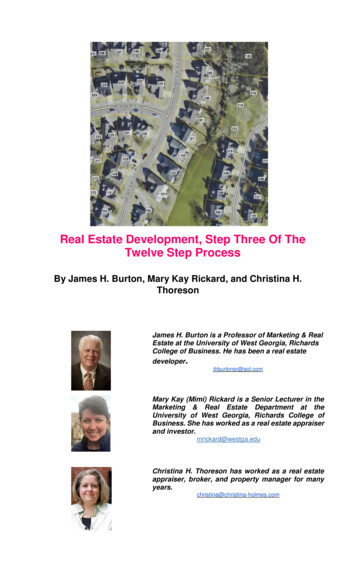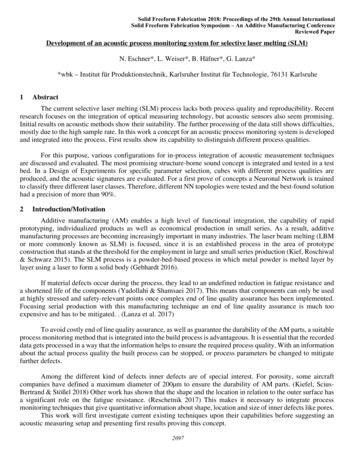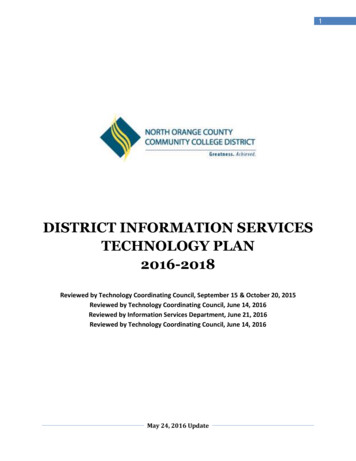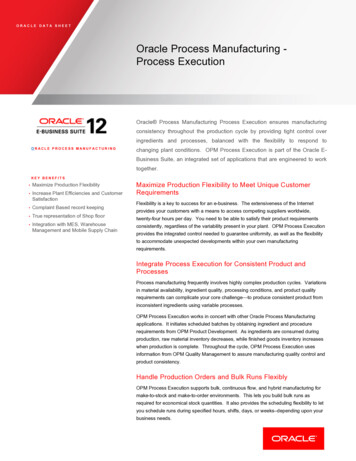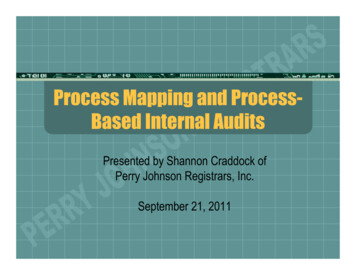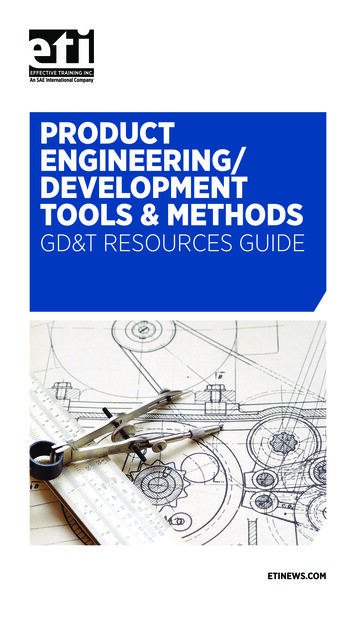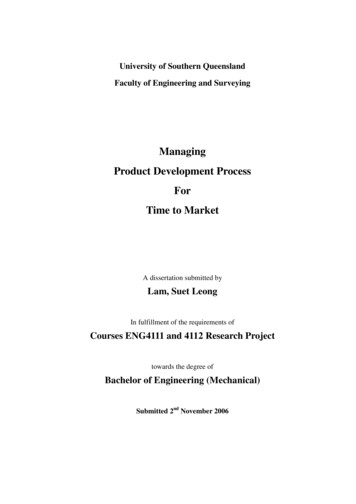
Transcription
University of Southern QueenslandFaculty of Engineering and SurveyingManagingProduct Development ProcessForTime to MarketA dissertation submitted byLam, Suet LeongIn fulfillment of the requirements ofCourses ENG4111 and 4112 Research Projecttowards the degree ofBachelor of Engineering (Mechanical)Submitted 2nd November 2006
AbstractIn a business environment with intense competition, technology businesses launch newproducts to market rapidly. Marketing strategies and technological factors, which aredriven by business environments, continue to shorten product development from yearsto months. Product development must be executed with speed, thus managing for Timeto-Market is therefore very important for the competitive success of such companies inthe marketplace.This research aims to establish an effective and efficient product development processbased on a ‘Gateway Review’ framework to ensure best practices and compliance ofeach phase of a new product development, providing the Project Manager and teammembers with a systematic way to execute their product development projects for rapidTime-to-Market focus.Adopting top-down concept, a Product Development framework is created from thehigher level Product Life Cycle framework as shown in the diagram below. Gatecheckpoints and functional process checkpoints are established throughout the durationof the development.Checklists are used as the validation tool to assure compliance of all processes requiredat each checkpoint. The checkpoints will thus conclude with a decision point onwhether to continue with the project or not.While formal project management processes may be in place for larger productdevelopment projects, many companies do not adequately use these tools and suffer theconsequences. Significant opportunities exist to reduce time-to-market by a better focuson product planning, project planning and resource management. A strategic step is torealistically plan projects based on the tailored product development process.I
Disclaimer PageUniversity of Southern QueenslandFaculty of Engineering and SurveyingENG4111 & ENG4112 Research ProjectLimitations of UseThe Council of the University of Southern Queensland, its Faculty of Engineeringand Surveying, and the staff of the University of Southern Queensland, do not acceptany responsibility for the truth, accuracy or completeness of material containedwithin or associated with this dissertation.Persons using all or any part of this material do so at their own risk, and not at therisk of the Council of the University of Southern Queensland, its Faculty ofEngineering and Surveying or the staff of the University of Southern Queensland.This dissertation reports an educational exercise and has no purpose or validitybeyond this exercise. The sole purpose of the course pair entitled "Research Project"is to contribute to the overall education within the student’s chosen degree program.This document, the associated hardware, software, drawings, and other material setout in the associated appendices should not be used for any other purpose: if they areso used, it is entirely at the risk of the user.Prof G BakerDeanFaculty of Engineering and SurveyingII
CertificationI certify that the ideas, design and experimental work, results, analyses and conclusionsset out in this dissertation are entirely my own effort, except where otherwise indicatedand acknowledged.I further certify that the work is original and has not been previously submitted forassessment in any other course or institution, except where specifically stated.Lam Suet LeongStudent Number: 0050015125Signature2nd November 2006DateIII
AcknowledgementsThis research was carried out under the supervision of Mr. Bob Fulcher from theUniversity of Southern Queensland. I would like to thank him for his continuousassistance and patience during the course of my research.Although this final report reflects the work of one individual, it could not have beencompleted without the help and support of my fellow colleagues at my workplace. Tohonor their request for confidentiality, I would like to thank them collectively in thisacknowledgement.My appreciation also goes to the staff of the University of Southern Queensland for allof their assistance in seeing this dissertation completed.Finally, my deepest thank to my wife, Kristy, my son, Jing Jie, and my daughter WeiLin, for their infinite patience and understanding throughout this endeavor.IV
Table of ContentsAbstract . IDisclaimer Page.IICertification. IIIAcknowledgements . IVList of Figures . VIIIList of Tables. VIIIAcronyms and Abbreviations. IXGlossary of Terms. XIChapter 10Background . 2Objectives . 3Overview (Organization of Study). 4Scope and Limitations. 6Research Methodology. 7Consequential Effects of the Research . 9Safety Issues .9Environmental Protection.9Ethical Issues.9Implementation issues .10Risk Assessment. 11Resource Analysis. 14Project Timelines . 15Conclusion . 16Chapter 22.12.22.32.3.12.3.22.3.32.42.52.6Introduction .1Key Concept of Product Development .17Modern Marketing Strategy. 18Project Management Review. 21Outsourcing. 24Benefits of Outsourcing.24Potential Drawbacks .24Types of Outsourcing Services .25Product Life Cycle (PLC) . 28Product Development. 31Intellectual Property . 32V
2.72.7.12.7.22.8Environmental Sustainability. 35What is DfE and its benefits? .37Legal requirements for Environmental Sustainability .40Conclusion . 43Chapter 33.13.23.2.13.2.23.2.33.3What is Project Management? . 45Project Management Fundamental . 48Define and Organize the Project .49Plan the Project.64Track and Manage the Project.75Conclusion . 79Chapter hing Product Development Framework .80Defining Product Life Cycle (PLC) . 81Opportunity Phase.82Concept Phase.83Development Phase.84Production Phase and Phase-Out.84Product Development Framework under PLC Context. 85The Scope of Product Development Process. 87The Main Processes of Product Development . 88Functional Processes and Supporting Processes . 89Product Development.89Industrialization .89Supporting Processes.91Project Team Structure . 92Roles and Responsibilities. 94Product development Specifications. 95Product builds: some semantics . 95Conclusion . 96Chapter 55.15.2The Philosophy of Project Management .44Organizing Product Development Process .97Product Life Cycle Gate Checkpoints . 98GCP Deliverables and Exit Criteria by Phases . 99Opportunity Phase Deliverables .100Concept Phase Deliverables.102Development Phase Deliverables.104Production Phase Deliverables .107Summary of Gate Checkpoint Requirements .109VI
5.35.3.15.3.25.3.35.3.45.3.55.3.65.3.75.4Product Development Process Flow and Checkpoints. 110Proposal Generation Process Flow .113Requirement Analysis Process Flow .114Architectural Design Process Flow .115Detailed Development Process Flow .116Design Validation Process Flow .117Process Validation Flow.118Product Development Process Documents .119Conclusion . 125Chapter 66.16.2Case Study 1. 127Case Study 2. 130Chapter 77.17.2Review Performance and Underlying Problem.126Recommendation and Further Works .131Achievement of Objectives . 132Proposal for future works. 133Reference .1Appendices.2Appendix A: Project Specification. 2Appendix B: Gate Checklists. 4Appendix C: Functional Process Checklists . 17Appendix D: Templates . 44Appendix D1: Risk Assessment and Control Table .45Appendix D2: Gate Checkpoint Checklist .48Appendix D3: Functional Process Checklist .50Appendix D4: Project Team Member List.52Appendix D5: Project Feasibility Study Report .54Appendix D6: Design Requirement Document.57Appendix D7: Assignment Specification .
Abstract. In a business environment with intense competition, technology businesses launch new products to market rapidly. Marketing strategies and technological factors, which are driven by business environments, continue to shorten product development from years to months.
